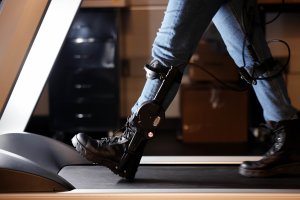Presented By: Michigan Robotics
Characterizing Human-Exoskeleton Fluency for Co-Adaptive Control of Ankle Exoskeletons
PhD Defense, Man I (Maggie) Wu

Chair: Leia Stirling
Abstract:
The performance of assistive and augmentative lower-limb exoskeletons have been tested in laboratory settings and can achieve goals of improved walking economy and metabolic cost reduction. However, it has been shown that even in controlled laboratory environments, exoskeletons may experience errors of improper torque assistance due to misalignments between the measured and actual state of the human-exoskeleton system. In order for exoskeletons to be adopted for everyday use, it is important to understand the immediate and long-term effects of exoskeleton errors on user motion and trust in the system, as errors are likely to occur in operational settings with complex, changing environments.
The main aims of this thesis are to characterize the (1) immediate effects and (2) residual effects of exoskeleton errors on human gait strategies, as well as (3) develop a co-adaptive exoskeleton controller to support collaboration between the user and exoskeleton. In this thesis, we identified and characterized the immediate compensatory behavior and emergent gait strategies developed as users walked imperfect exoskeleton algorithms with fixed error frequencies. We developed quantitative measures of human-exoskeleton fluency---the alignment of the user and exoskeleton's goals---using joint kinematics and muscle activity metrics. We then designed and modeled a co-adaptive control algorithm that supports human-exoskeleton fluency by adjusting torque assistance in response to measures of muscle activity and joint kinematics along the lower limbs. The proposed co-adaptive algorithm successfully modulated peak torque in response to various fluent and non-fluent behaviors compared to an ankle-only controller that did not account for hip and knee compensatory strategies.
Zoom passcode: exo
Abstract:
The performance of assistive and augmentative lower-limb exoskeletons have been tested in laboratory settings and can achieve goals of improved walking economy and metabolic cost reduction. However, it has been shown that even in controlled laboratory environments, exoskeletons may experience errors of improper torque assistance due to misalignments between the measured and actual state of the human-exoskeleton system. In order for exoskeletons to be adopted for everyday use, it is important to understand the immediate and long-term effects of exoskeleton errors on user motion and trust in the system, as errors are likely to occur in operational settings with complex, changing environments.
The main aims of this thesis are to characterize the (1) immediate effects and (2) residual effects of exoskeleton errors on human gait strategies, as well as (3) develop a co-adaptive exoskeleton controller to support collaboration between the user and exoskeleton. In this thesis, we identified and characterized the immediate compensatory behavior and emergent gait strategies developed as users walked imperfect exoskeleton algorithms with fixed error frequencies. We developed quantitative measures of human-exoskeleton fluency---the alignment of the user and exoskeleton's goals---using joint kinematics and muscle activity metrics. We then designed and modeled a co-adaptive control algorithm that supports human-exoskeleton fluency by adjusting torque assistance in response to measures of muscle activity and joint kinematics along the lower limbs. The proposed co-adaptive algorithm successfully modulated peak torque in response to various fluent and non-fluent behaviors compared to an ankle-only controller that did not account for hip and knee compensatory strategies.
Zoom passcode: exo